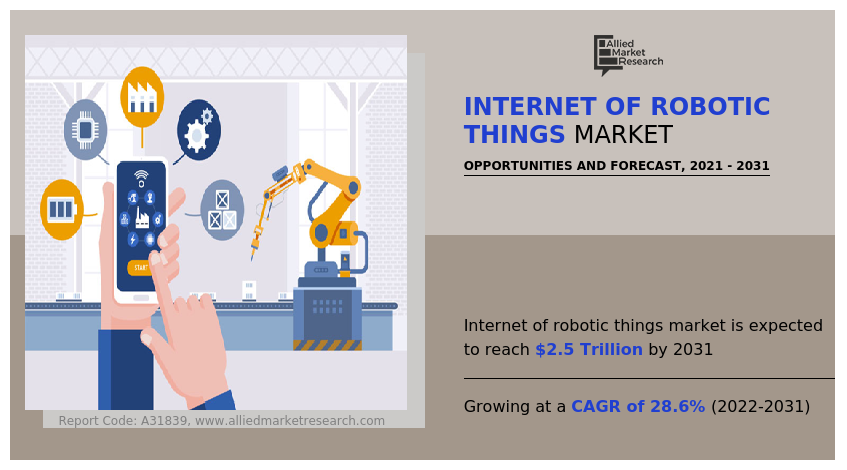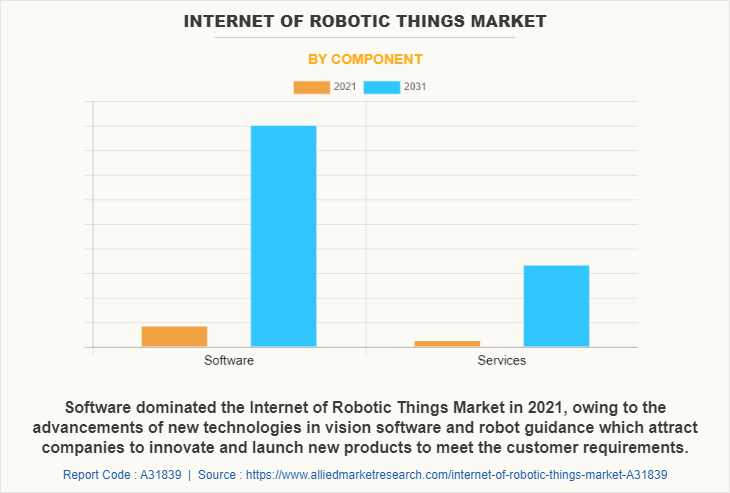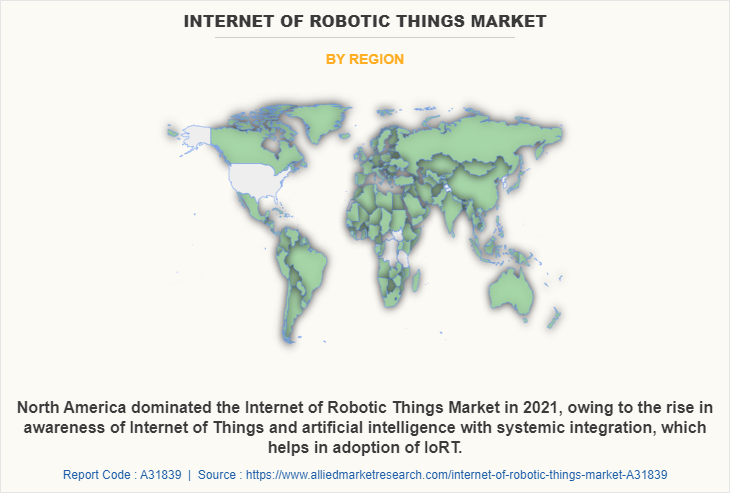Internet of Robotic Things Market Overview
The global internet of robotic things market was valued at $208 billion in 2021, and is projected to reach $2461.9 billion by 2031, growing at a CAGR of 28.6% from 2022 to 2031.
Surge in adoption in e-commerce sector and rise in implementation of new technologies integrated with robotics for industry 4.0 primarily drive growth of the internet of robotics things market. However, expensive R&D and maintenance and product development is a time consuming process hamper the market growth to some extent. Moreover, increasing deployment of robotics in education and health industry are expected to provide lucrative opportunities for internet of robotic things market growth during the forecast period.

The notion of the "Internet of Robotic Things" describes a network of intelligent devices that can observe events, combine sensor data from various sources, apply intelligence to decide on the best course of action, and move physical items. The Industrial Internet of Things, intelligent networking, cloud computing, artificial intelligence, digital twins, distributed ledger technology, and many more are the technologies that are most frequently employed in the IoRT. Robotics' increasing adoption across a range of technologies is expected to become the main driver of market expansion. Increased e-commerce platform proliferation and high-speed data access, particularly in developing nations, are anticipated to exacerbate the market growth. Other factors supporting the market's expansion include the decreased time needed to get a healthy return on investment and rising demand for robotics from the education sector.
However, the undeveloped and developing economies' lack of technological know-how is expected to limit the market's ability to flourish. In addition, problems with data security and interoperability as well as high deployment are projected to slow the market's growth. Moreover, long product development cycles is expected to slow the market's rate of expansion. The internet of robotic things market is segmented into Type, Platform, Component, End User and Software Type.
The internet of robotic things market is segmented on the basis of component, software type, platform, type, end user, and region. On the basis of component, it is segregated into software, and service. On the basis of software type, it is divided into network bandwidth management, data management, remote monitoring system, security solution, and real time streaming analytics. On the basis of type, it is bifurcated into sensors, actuators, control system, power source and others. On the basis of platform, it is classified into device management platform, application management platform, and network management platform. On the basis of end user, it is segregated into aerospace and defense, automotive and manufacturing, healthcare, food and beverages, logistics, media and entertainment and others. Region wise, the market is analyzed across North America, Europe, Asia-Pacific, and LAMEA.
On the basis of component, software dominated the internet of robotic things market share in 2021 and is expected to maintain its dominance in the upcoming years, owing to the advancements of new technologies in vision software and robot guidance attract companies to innovate and launch new products to meet the customer requirements, which drives market growth. However, the service segment is expected to witness highest growth, owing to the widespread adoption of IoRT and due to this robot’s performance is enhanced by sophisticated software design and architecture.

Region-wise, the internet robotic things market size was dominated by North America in 2021 and is expected to retain its position during the forecast period, owing to the surge in need of automation for modernization and expansion of production capacity. Furthermore, use of internet of robotic things technology increases production efficiency, reduces cost and saves space. However, Asia Pacific is expected to witness significant growth during the forecast period, owing to the increase in need of robots for security and surveillance, which is expected to fuel the market growth in this region. Furthermore, several major workplace safety solution providers including ABB Ltd., Aethon inc., Amazon.com, Bluefin Robotic Corporation, Cisco, Google, Intel Corporation, iRobotic Corporation, are introducing new products & services to IRoT safety.

The internet of robotic things industry is dominated by key players such as ABB Ltd., Aethon inc., Amazon.com, Bluefin Robotic Corporation, Cisco, ECA Group, FANUC Corporation, Google, Intel corporation, iRobotic Corporation. These players have adopted various strategies to increase their market penetration and strengthen their position in internet of robotic things industry.
Top Impacting Factors
Rising adoption in e-commerce sector
One of the industries with the most widespread implementation of IoRT is e-commerce. The e-commerce industry's adoption of IoRT, the expansion of robots' potential application areas as a result of technology integration, and the market's rapid ROI and payback periods are the primary factors driving this market's growth. Robots powered by IoRT that are capable of automatically identifying and resolving systemic issues are a crucial step toward reducing human interference in supply chains. Moreover, in the future, lower and middle-tier employees at various e-commerce facilities are expected to be extremely understaffed or nonexistent. Soon enough, intelligent IoRT systems will be able to fully satisfy all of users’ needs due to the increasing automation of the manufacturing and shipping sectors.
Rising implementation of new technologies integrated with robotics for industry 4.0
New technologies integrated with IoRT are being used more frequently in production, services, and communications. The new fourth industrial revolution, known as "Industry 4.0," promotes organizational effectiveness. Robotics is a key Industry 4.0 technology that offers a wide range of manufacturing-related capabilities. This technology has improved automation systems and efficiently and accurately completes repetitive tasks. Furthermore, robotics is steadily enabling the production of high-quality goods while preserving the worth of current worker compensation plans. Industry 4.0's main result is the development of intelligent factories that are extremely powerful, secure, and cost-effective thanks to improved robotics, vast data, cloud computing, strong safety, intelligent sensors, the Internet of Robotic Things, and other cutting-edge technological advancements. As a result, companies are widely adopting IoRT to improve the production.
Technological Trends
The Internet of Things (IoT), artificial intelligence (AI), and robots are the main forces behind the digital transformation that is improving how people live and conduct business. These three technologies working together have the ability to alter how businesses, industries, and economies operate. Each technology operates independently within the system and is vital to modern users' day-to-day operations. These technologies are used by people to mimic intelligent conduct that will help with their demanding work schedules. AI, IoT, and robotics have practically endless applications in all facets of our life. These contemporary technologies are used in all aspects of modern life, including manufacturing, digital marketing, and providing precise medical treatment and surgical operations. The expansion of COVID-19 has further boosted artificial intelligence's global growth. Transportation services was one of many companies looking to cut back on technology spending. The internet of robotic things would eventually move beyond smart gadgets to include robotics, According to current IoRT tendencies, robots may soon replace humans in number of physically taxing and repetitive tasks.
Government Initiatives
Even though AI has proven benefits for our daily lives, some individuals are worried about potential risks. Damage from AI could include inadequate physical security, financial losses, and moral dilemmas, to name a few. The European Union is developing a legal framework to control artificial intelligence in response to the risks it poses. The European Commission recently put up its initial artificial intelligence legislative framework. The European authorities' extensive and difficult work has led to this suggestion. An earlier resolution from the European Parliament contained advice for the European Commission. Prior to that, the European Union's legislators passed the 2017 Resolution and the 2020 report that accompanied the European Commission's "White Paper on Artificial Intelligence" on the safety and liability implications of artificial intelligence, the Internet of Things, and robotics.
The European Parliament stated that the current legal system lacks a specific discipline on the liability of AI-systems in its Resolution from October 20, 2020 on the civil liability framework for artificial intelligence. According to the legislative body, it is difficult to pinpoint individual human decisions because of the capabilities and autonomy of the technology. As a result, without evidence of the operator's liability, the person who sustains harm through AI systems typically cannot be reimbursed. For this reason, the Resolution included recommendations for the European Commission in annex B to the proposal. There are five chapters, 17 pages, and 15 articles in this proposal. The European Commission created a 108-page document with nine annexes on April 21, 2021, in response to the suggestions of the European Parliament. This paradigm employs a risk-based approach to categories the uses of AI depending on whether they provide a high danger, an unacceptable risk, or a low risk. If the risk clearly endangers people's security and fundamental rights, it is inappropriate and is therefore forbidden. The European Commission has identified systems that enable social-credit rating and AI applications that affect human behavior as examples of unacceptable risk.
Key Benefits for Stakeholders
This report provides a quantitative analysis of the market segments, current trends, estimations, and dynamics of the internet robotic things market analysis from 2021 to 2031 to identify the prevailing internet of robotic things market opportunities.
The market research is offered along with information related to key drivers, restraints, and opportunities.
Porter's five forces analysis highlights the potency of buyers and suppliers to enable stakeholders make profit-oriented business decisions and strengthen their supplier-buyer network.
In-depth analysis of the internet robotic things market forecast assists to determine the prevailing market opportunities.
Major countries in each region are mapped according to their revenue contribution to the global market.
Market player positioning facilitates benchmarking and provides a clear understanding of the present position of the market players.
The report includes the analysis of the regional as well as global internet of robotic things market trends, key players, market segments, application areas, and market growth strategies.
Internet of Robotic Things Market Report Highlights
| Aspects | Details |
| Market Size By 2031 | USD 2461.9 billion |
| Growth Rate | CAGR of 28.6% |
| Forecast period | 2021 - 2031 |
| Report Pages | 337 |
| By Type |
|
| By Platform |
|
| By Component |
|
| By End User |
|
| By Software Type |
|
| By Region |
|
| Key Market Players | FANUC CORPORATION, Amazon.com Inc., Cisco Systems Inc., ABB Ltd., Google LLC, Intel Corporation, Bluefin Robotics Corporation, eca group, Aethon Inc., iRobot Corporation |
Analyst Review
According to the CXO's of leading market players, a number of factors contributed to the Internet of Robotic Things market's expansion. IoRT refers to intelligent robots that are connected to the Internet and used for either business or personal tasks, such as manufacturing and watching over the activities of elderly people. They are intelligent machines that help monitor activities and manage physical items by collecting sensor data from many sources and deciding on the best course of action.
High-speed data connectivity and smooth online access are the main drivers for internet of robotic things market growth. The rise in the use of digitalization, the aging population, smart gadgets used in e-commerce, automation in industry, the expansion of broadband infrastructure, and urbanization are all factors boosting the market for IoRT . However, issues impeding the growth of the Internet of Robotic Things market include a lack of knowledge of Internet of Robotics technology, expensive R&D activity costs, and complexity in new product development.
Rise in adoption of industrial robots by small and medium-sized businesses and expanding needs for different types of access and control over robotics technology devices across industry verticals are anticipated to present opportunities for vendors operating on the Internet of Robotic Things Market.
Surge in adoption in e-commerce sector and rise in implementation of new technologies integrated with robotics for industry 4.0 primarily drive growth of the Internet of robotics things market.
North America is the largest region for Internet of Robotic Things Market
The internet of robotic things market size was valued at $207948.25 million in 2021, and is projected to reach $2461942 million by 2031, growing at a CAGR of 28.6% from 2022 to 2031.
The key players operating in the market include ABB Ltd., Aethon inc., Amazon.com, Bluefin Robotic Corporation, Cisco, ECA Group, FANUC Corporation, Google, Intel corporation, iRobotic Corporation. Furthermore, it highlights the strategies of the key players to improve the market share and sustain competition.
Loading Table Of Content...



